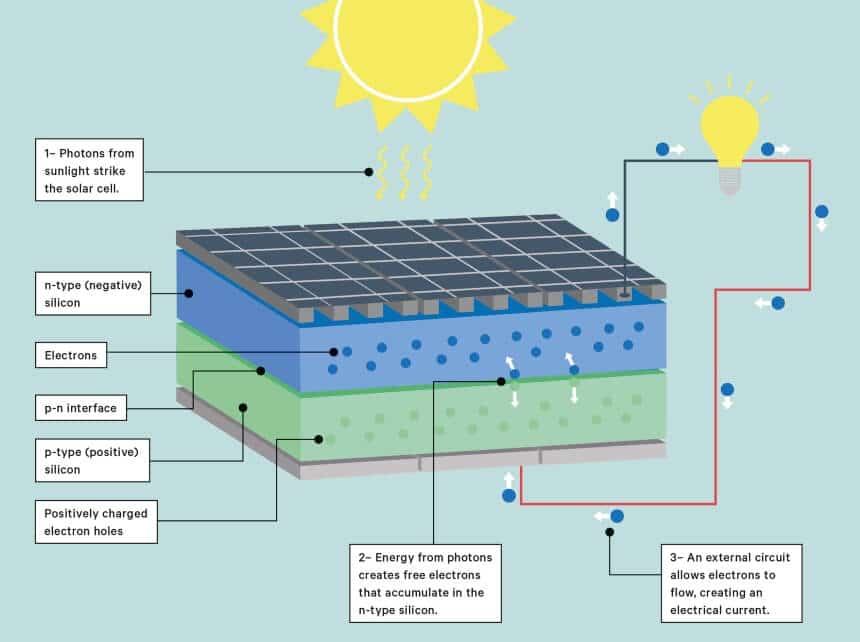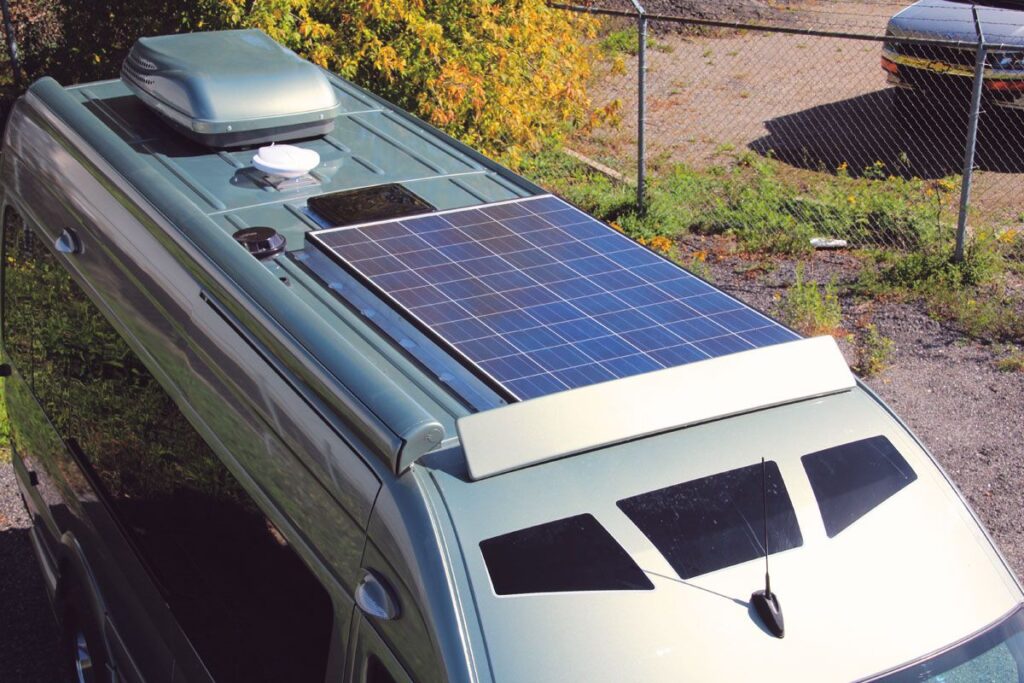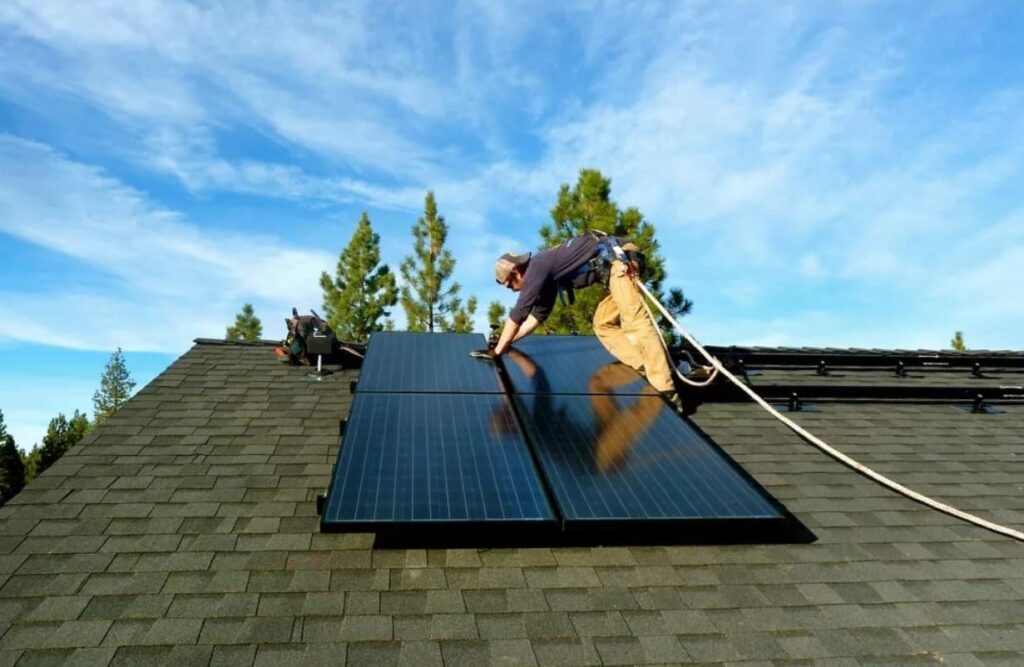For a long time, the sun has been the most promising source of clean energy. But, despite developments in technology, solar panels currently only convert less than 20% of the sun’s energy into electricity. The highest efficiency achieved so far is probably 33.3% Trusted Source Converts One-third of the Sunlight into Electricity: 33.3 Percent Silicon-based Multi-junction Solar Cell - Fraunhofer ISE Researchers at the Fraunhofer ISE together with the company EV Group (EVG) have developed a new silicon-based multi-junction solar cell, which can convert exactly one-third of the incident sunlight into useful electricity. www.ise.fraunhofer.de , under ideal lab conditions.
Why should you be worried about how to calculate solar panel efficiency? For starters, higher efficiency provides a higher energy density, which means you can install fewer panels and thus save on installation costs.
More importantly, learning about solar panel efficiency will help you understand what you can do to ensure that your solar panels continue operating at maximum capacity. High-efficiency solar panels can actually be more practical than generators, if you’re trying to decide between the two.
This simple guide will show you the no-sweat method to finding out ideal and practical efficiency.

A photovoltaic or solar cell is a sandwich of silicon semiconductors, the same material that powers much of our electronics today. The top layer of the cell has more electrons due to the addition of a little phosphorus (a process called doping), while the bottom layer has fewer electrons due to doping with boron.
This charge difference creates an electric field between them that causes electrons to flow when light energy strikes the cell. Metal strips at the edges of the cell collect these electrons from each cell and form the circuitry that transfers solar energy.
You may be interested to learn that solar panels don’t necessarily have to be made of glass. There are now flexible solar panels and even wearable models that can be incorporated into building materials, cars, and more.
Solar panel efficiency is the percentage of solar energy that gets converted into electricity by the photovoltaic cells in the solar panel.
To make it easier to measure efficiency, solar panels are tested under average conditions known as Standard Test Conditions or STCs. These conditions are industry standards as agreed upon by manufacturers and various institutions and are currently set at:
Tested thus under standard conditions, we can then compare each solar panel’s efficiency. For example, a panel with an efficiency of 22% will convert 4% more sunlight into energy than a panel rated at 18%.
Your solar panel’s maximum efficiency is usually readily available with the manufacturer’s specifications. However, this will be an ideal value measured under STC conditions. It won’t be of much use to you unless your module operates under similar conditions as STC.
By calculating your practical or real-world efficiency, you can then find out just how much energy your solar panels are producing. Here is the step-by-step process detailing what you need to do to calculate solar panel efficiency output.

If you don’t have the surface area expressly stated, you can simply calculate that by multiplying the length and width of the panel. For example, typical solar panel dimensions measure 65” by 39”, or 1.651m x 0.9906m, giving an area of 1.6355m2.
The next step is to find out the efficiency per unit area of the panel. This will allow you to calculate the efficiency of every solar cell, after which you can also calculate the total output of a whole bank of solar panels.
To do that, simply divide the maximum power capacity (the rating found on the nameplate or manufacturer’s datasheet) with the surface area. The result will be in Watts per square meter, or W/m2.
The manufacturer tests the solar panel’s efficiency at standard STC values, which will be different in real-world applications. In the US, you can find your region’s solar irradiance information from the National Renewable Energy Laboratory website Trusted Source Solar Resource Data and Tools | Grid Modernization | NREL NREL provides solar resource data and tools to help energy system designers, building architects and engineers, renewable energy analysts, and others accelerate the integration of solar technologies on the grid. www.nrel.gov .
Temperature information also varies. The nominal operating cell temperature (NOCT) used by the manufacturer is based on a moderate irradiance value of 800W/m2 at ambient temperatures of 200C. However, they also supply a temperature coefficient of Pmax that you can use to find out the actual efficiency loss at temperatures higher than 250C.
For every degree that the operating temperature exceeds NOCT, the panel loses a specific value of percentage efficiency. You can find this temperature by using a flat surface temperature sensor, although some panel arrays come with one already mounted.
Subtract the temperature difference from the STC value and multiply it by the Pmax coefficient. For example, if the panel temperature is 350C, multiply (35-25) x (Pmax). You will get a negative number as a result, which you will then subtract from the ideal efficiency value to find actual efficiency at the higher temperatures.
Thus, if you get 4.5% and your panel has an ideal efficiency of 18%, then the operating efficiency would be 13.5%.
The following formula tells you how to calculate the efficiency of a solar panel:
Solar panel efficiency = Unit Area (W/m2) / Solar irradiance value (W/m2)
The number you get is a ratio, so you can simply multiply that by 100 to find the percentage efficiency. Remember to use local values of irradiance and subtract the efficiency loss from high temperatures as indicated in step #3. Your final answer is the panel’s operating efficiency, which will help you find out the actual energy output.
One of the best 100W solar panels we have seen is the Renogy 12V portable solar panel suitcase. Designed for a lifestyle on the move, the foldable solar panel has a rated efficiency of 21% and comes with an attached charge controller. Users loved this model’s build quality, although installation may require a bit of customization.
At the same time, weather conditions vary from place to place. Places receiving direct sunlight and minimal cloud cover (such as deserts) have a big advantage over those that receive less sunlight per day.
Above or below the nominal cell temperature (NOCT), the panel loses efficiency at a fixed rate per Celsius known as the temperature coefficient of Pmax. Pmax varies between solar panels based on the manufacturer.
Premium quality solar panels have a higher efficiency than standard quality panels. New panels are also more efficient, losing about 0.8% of their efficiency every year. High-end panels have a lower degradation rate and thus maintain a high efficiency for far longer. For this reason, we also put together a review of the best solar panels to help you get the best quality.
The efficiency of other components such as inverters and charge controllers also affect the energy output of your solar panels. High efficiency inverters make sure that there is minimal energy loss between the solar panel output and the electrical energy delivered to your home.
The operating conditions of the panel such as shading, maintenance, and installation position affect efficiency. Ideal, solar panels are inclined at 450 to the horizontal for maximum incidence rate. They are also placed far away from trees and the shade of buildings, which can severely affect the intensity and energy of incident sunlight reaching the panels.
In general, while solar panel efficiency is an important factor, there is a lot more you have to consider before making a choice. One of the most recommended choices is the Renogy 24V 600W Grid monocrystalline panels for home and cabin installation. Able to withstand snow buildup, harsh winds, and high temperatures, the unit loses only 5% efficiency over 5 years.
Solar panel efficiency is a critical factor in the success of every solar energy power plant. Whether that’s an RV package for living off the grid or a residential unit to reduce energy bills, higher efficiency converts more free sunlight to usable electricity and saves on installation costs.
However, we still have a long way to go when it comes to increasing solar panel efficiency, given that less than a fifth of incident sunlight is typically converted to electricity. Advances in technology are promising 30% or more in a few years.
Learning how to calculate solar panel efficiency can also help you decide when it’s time to upgrade older panels. If you’re looking to do that or venture into clean energy for the first time, there isn’t a more exciting time to do that than right now.





